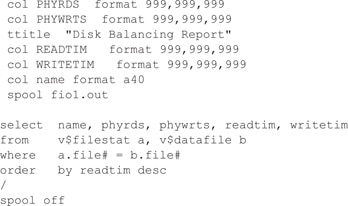Disk contention occurs when multiple processes try to access the same physical disk simultaneously. Disk contention can be reduced, thereby increasing performance, by distributing the disk I/O more evenly over the available disks. Disk contention can also be reduced by decreasing disk I/O.
To monitor disk contention, review the Database Files Metrics in Database Control. This Metric group contains two sets of metrics. The Average File Read Time and Average File Write Time apply to all datafiles associated with your database. If you find that one or two datafiles seem to have especially high values, you click one and then use the Compare Objects File Name link to view collected statistics between them. If they are both busy at the same time and are on the same disk, you may choose to relocate one datafile to another filesystem, if you are concerned about performance during that time.
You can also determine file I/O problems by running a query:

Here is a partial query output:

NOTE
You may also have SYSAUX01.DBF, USERS01.DBF, and EXAMPLE01.DBF.
TIP
Query V$FILESTAT and V$DATAFILE to see how effectively datafiles have been balanced. Note that temporary tablespaces are monitored using V$TEMPFILE and V$TEMPSTAT.
Leave a Reply